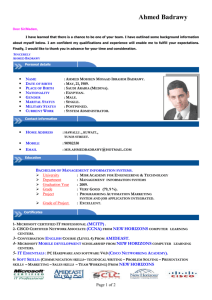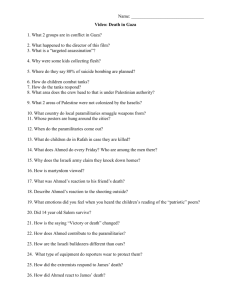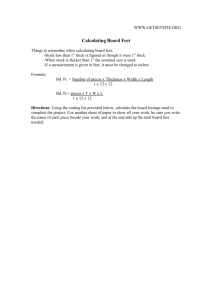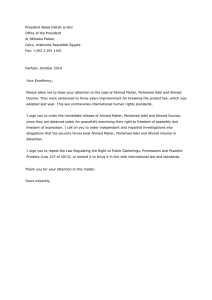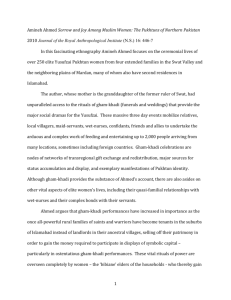Examples :-In the following table, specifications ... and the diameter of the ...
advertisement
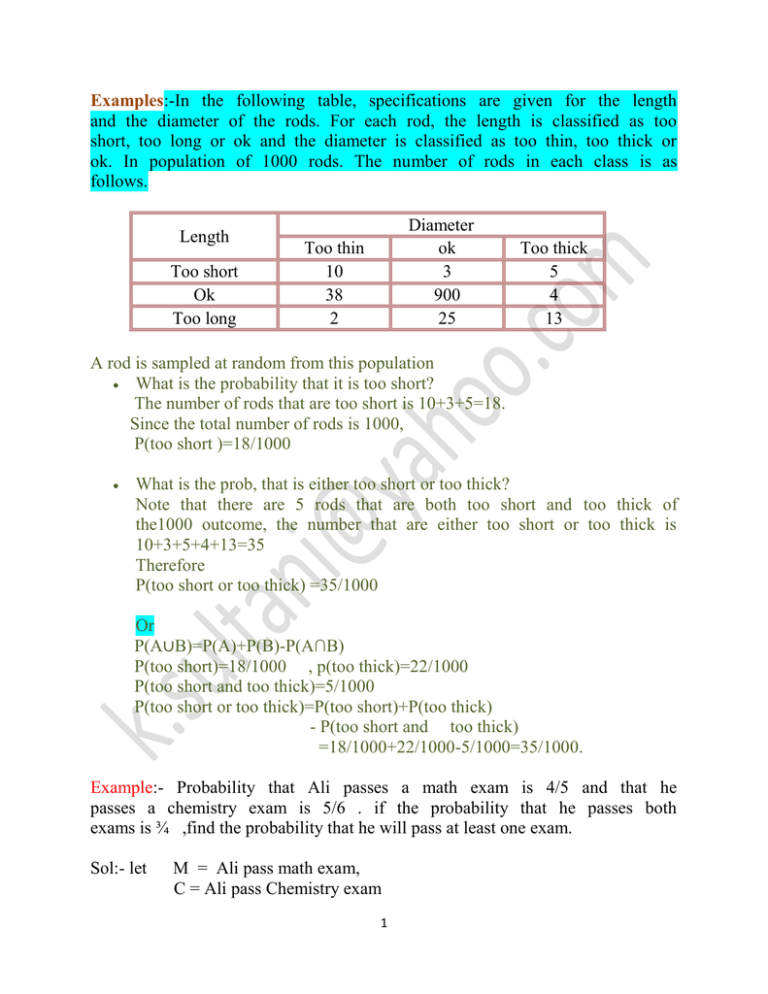
Examples:-In the following table, specifications are given for the length
and the diameter of the rods. For each rod, the length is classified as too
short, too long or ok and the diameter is classified as too thin, too thick or
ok. In population of 1000 rods. The number of rods in each class is as
follows.
Length
Too short
Ok
Too long
Diameter
ok
3
900
25
Too thin
10
38
2
Too thick
5
4
13
A rod is sampled at random from this population
What is the probability that it is too short?
The number of rods that are too short is 10+3+5=18.
Since the total number of rods is 1000,
P(too short )=18/1000
What is the prob, that is either too short or too thick?
Note that there are 5 rods that are both too short and too thick of
the1000 outcome, the number that are either too short or too thick is
10+3+5+4+13=35
Therefore
P(too short or too thick) =35/1000
Or
P(A∪B)=P(A)+P(B)-P(A∩B)
P(too short)=18/1000 , p(too thick)=22/1000
P(too short and too thick)=5/1000
P(too short or too thick)=P(too short)+P(too thick)
- P(too short and too thick)
=18/1000+22/1000-5/1000=35/1000.
Example:- Probability that Ali passes a math exam is 4/5 and that he
passes a chemistry exam is 5/6 . if the probability that he passes both
exams is ¾ ,find the probability that he will pass at least one exam.
Sol:- let
M = Ali pass math exam,
C = Ali pass Chemistry exam
1
P(Ali pass at least one exam)=p(M∪C)
=P(M)+P(C)-P(M∩C)
=4/5+5/6-3/4=53/60.
Example:- If the probability of success in one of the tests is equivalent to
0,6and the probability of success of Mohammed and Ahmed together in
this test equal to 0.1. Find the probability of success Mohammed and
failure of Ahmed.
A= {success of Mohammed}
B= {success of Ahmed}
A∩B= {Success of Mohammed and Ahmed}
𝐵𝑐 = {failure of Ahmed}
A∩𝐵𝑐 = {success of Mohammed and failure of Ahmed}
P (A) =0.6, P (A∩B) =0.1
P (A∩𝐵𝑐 ) =P (A)-P (A∩B)=0.6-0.1=0.5
Example:- same as in previous example, we use the definition of events
as follows:
A= {success of Mohammed}, P (A) =0.25
B= {success of Ahmed}
𝐵𝑐 = {failure of Ahmed}, P (𝐵𝑐 )= 0.3
A∩B= {Success of Mohammed and Ahmed}
P (A∩B) =0.1
Find Probability of success at least one of them.
A∪B= {Success at least one of them}
= {Success of Mohammed or success of Ahmed}
P(A∪B)= P(A)+P(B)-P(A∩B) =0.25+0.7-0.1 =0.85
1-P (𝐵𝑐 ) =1-0.3=0.7
Example:- If the Probability that a blood type one of blood donor be of the
kind
A is 0.35 and the probability that this is an infected donor’s blood
pressure is 0.15 and the probability that this donor is infected blood
pressure or that the group of his blood type A is 0.40.
Find the probability
1. Infected blood pressure and blood group type A
2. Uninfected blood pressure.
SoL
A={donor blood group type A
B={An infected donor blood pressure}
2
1- P(A∪B) =0.40 , P(B)=0.15 , P(A) = 0.35
P(A∩B) = P(A)+ P(B)- P(A∪B)
= 0.35+0.15-0.40= 0.10
𝑐
2- P𝐵 )= 1- P(B) =1-0.15
=0.85
Rule for non-independent events
How can we compute P(A ∩ B) when A and B are not independent?
Answer: Use the formula for conditional probability:
P(B|A) =P(A ∩ B)/P(A)
Clearing the denominator, Product rule:
P(A ∩ B) = P(A) ・ P(B|A)
The properties of probabilities
1. P(B|B) = 1
2. P(A∪C|B) = P(A|B)+ P(C|B) ; for A∩C = ɸ
3. If A ⊆ B, then A∩B = A so P(A|B) =P(A)/P(B), for A ⊆ B.
Example
A die is rolled and the number showing recorded. Given that the number
rolled was even, what is the probability that it was a six?
Let E denote the event “even” and F denote the event “a six”. Clearly F ⊆
E, so
P(F|E) =P(F)/P(E) =1/6/1/2=1/3.
Example
A coin is fair, the events H, T form a partition of the sample space, since one and only one will
occur, and all can occur.
3
